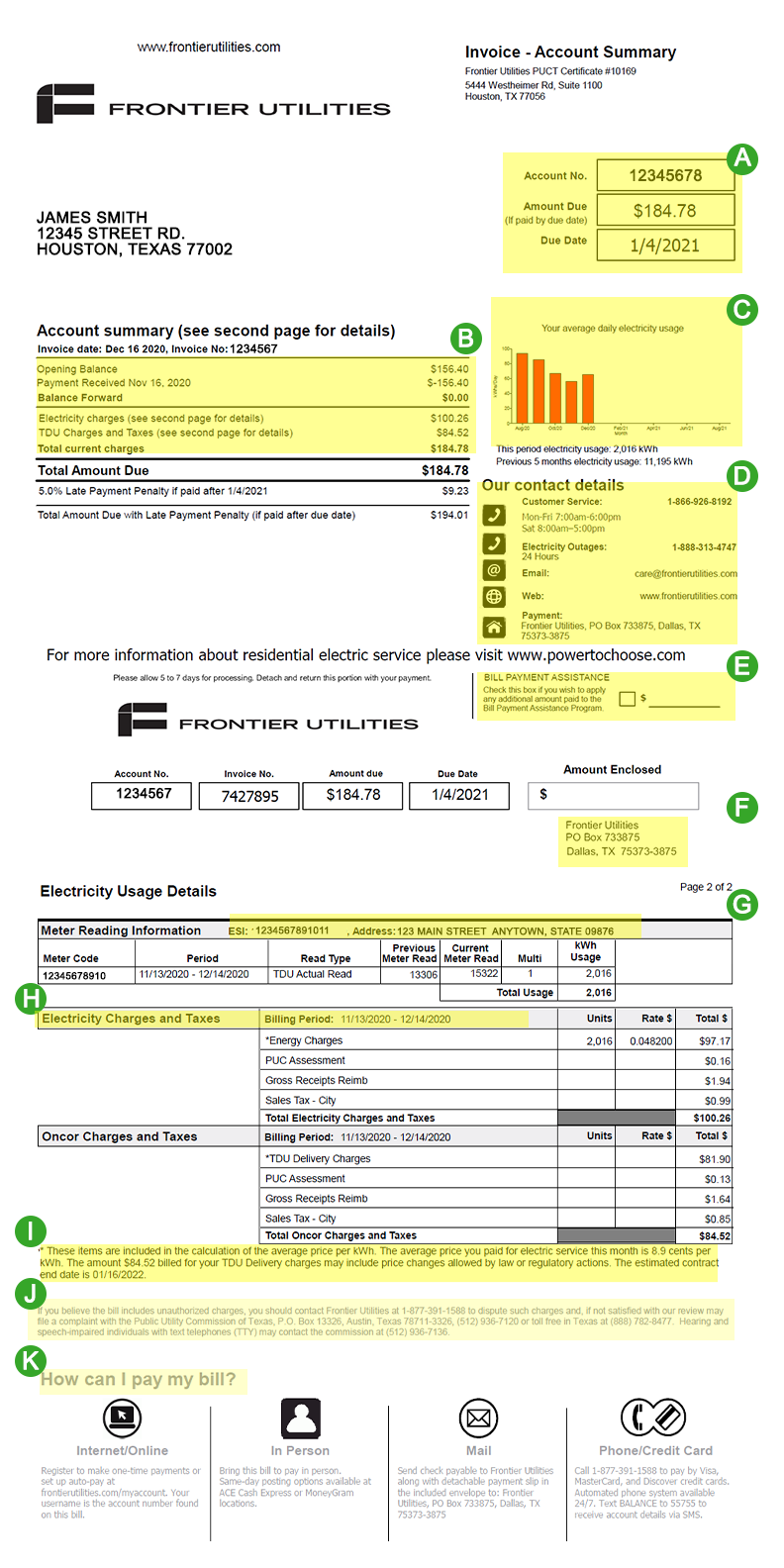Billing Statement Format
Here are some of the most important features that can be found on your new Frontier Utilities billing.
Please note that standard Residential and Commercial bills are virtually identical, except for the TDU (TDSP) Delivery Charges.
On Residential bills, all TDU (TDSP) Delivery charges are combined into a single line item; on Commercial bills, these charges are itemized as separate line items.
See the Billing Terms page for more information on the terms and line items that appear on your bill.

A
Your New Account Number – You will need this number for any account related inquiries.
Amount Due – Amount required to pay by due date to avoid a late payment penalty.
Due Date – Your payment is due on this date.
B
Invoice Date – The date your bill was issued.
Opening Balance – The total amount due from your previous bill.
Balance Forward – The difference between the Opening Balance and Payment. You owe this balance now (not when your current bill is due). If you have already paid this amount, it may still appear on your invoice. (if none is owed, this will appear as “$0.00”)
Frontier Utilities and TDU (TDSP) Charges – Total of the amounts in the Frontier Utilities Current Charges and TDU (TDSP) Current Charges sections.
Total Amount Due – The total amount charged by Frontier Utilities.
C
Average Daily Electricity Usage – Average daily electric usage by billing period.
D
Important Telephone Numbers – Contact information for account related questions and outage reporting.
E
Bill Payment Assistance Program – This program helps Frontier Utilities customers who need assistance to pay their electric bills. Customers may pledge any amount by checking the box on the remittance form.
F
Payment Remit Address – If the customer pays his/her bills through an automatic monthly payment or bank draft, "DO NOT PAY" will appear here along with the scheduled date and amount for the automatic payment. Otherwise, the customer may detach this form and include it with the bill payment. This portion includes the billing date, account number, payment due date, the customer's mailing address, the amount due, the payment remittance mailing address, and contact phone numbers for payment with a credit card.
G
ESI ID – The unique identifier created for your meter location by your TDU (TDSP).
Your Service Location – The address where electric service is being provided.
Meter Code – The number assigned to the electric meter at your premise by the TDU (TDSP).
Period – Date range in the meter reading cycle reflected on the bill
Reading Type – The meter reading may fall under two different types:
Actual Reading – A reading obtained from the meter by the TDU (TDSP).
Estimated Reading – A meter reading that was estimated by the TDU (TDSP).
Meter Readings (“Previous Meter Read,” “Current Meter Read”) – Readings for the current and previous billing periods taken from the electric meter by the TDU (TDSP).
Multiplier (Multi) – This number is used by the TDU (TDSP) to help determine the Power Usage for the billing cycle. (Most residences do not use a large amount of energy, so the multiplier is typically shown as “1.”)
Total Usage – Total amount of electricity (in kilowatt-hours, or kWh) consumed during the service dates shown (determined by subtracting the Previous Meter Read from the Current Meter Read, and then multiplying that number by the Multiplier; on the sample bill shown here, the calculation would be: 64931 - 64538 * 1 = 393 kWh)
H
Billing Period – The date range that electric service was provided for this billing period.
Electricity Charges – The amount of electricity you used (shown in kWh) times the price you pay per kWh. current billing period.
Rate – Identifies the account’s current rate plan.
PUC Assessment – Residents in an incorporated town or city with more than 1,000 residents are assessed this charge to recover the gross receipts tax imposed on retail electric providers.
Gross Receipts Tax Reimbursement – This is the charge assessed to recover the miscellaneous gross receipts tax imposed on retail electric providers operating in an incorporated city or town. The Miscellaneous Gross Receipts Tax is imposed on both utility companies and retail energy providers located in a city or town having a population of more than 1,000 according to the last federal census.
TDU (TDSP) Fixed and Usage Charges – This portion of the statement contains a list of charges for the current billing period from the customer’s Transmission and Distribution Utility, or TDU (TDSP) (the utility that owns or operates the equipment or facilities to transmit or distribute electricity to the location). These charges from the TDU (TDSP) are called “pass-through” charges, since they are charged to the customer by his/her TDU (TDSP) and “passed through” to the customer on the Frontier Utilities statement. Pass-through charges vary, may change from time to time, and are set by a complex schedule of rates and charges that is regulated by the PUCT.
TDU (TDSP) Delivery Charges – The total amounts assessed by a TDU (TDSP) for the delivery of electricity to a customer over poles and wires and other TDU (TDSP) facilities not including discretionary charges.
I
Average Price Paid for Electric Service – A calculation of the average unit price for electric service for the current billing period. The total average price for electric service reflecting all recurring charges, excluding state and local sales taxes, and reimbursement for the state miscellaneous gross receipts tax.
Service Plan End Date – If the customer is on a fixed-rate plan, the actual date when the contract ends appears here. (If the customer is on a variable rate plan, this area will appear blank).
J
Your Bill Payment Options – Details and contact information for Frontier Utilities’ bill payment options.